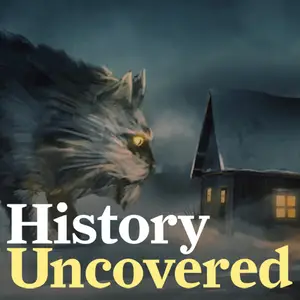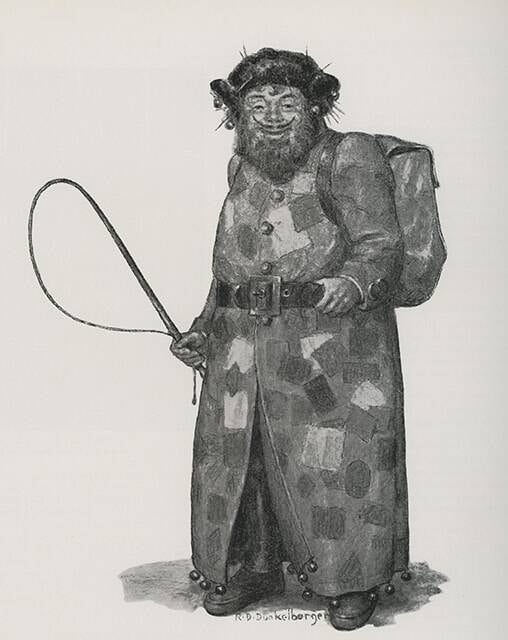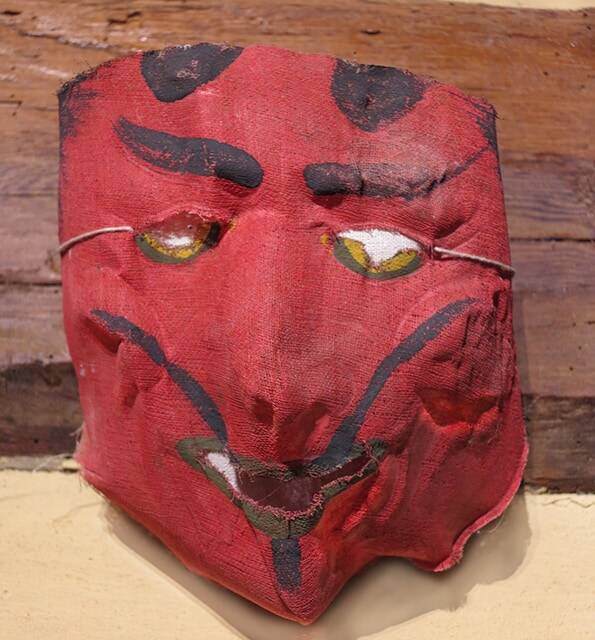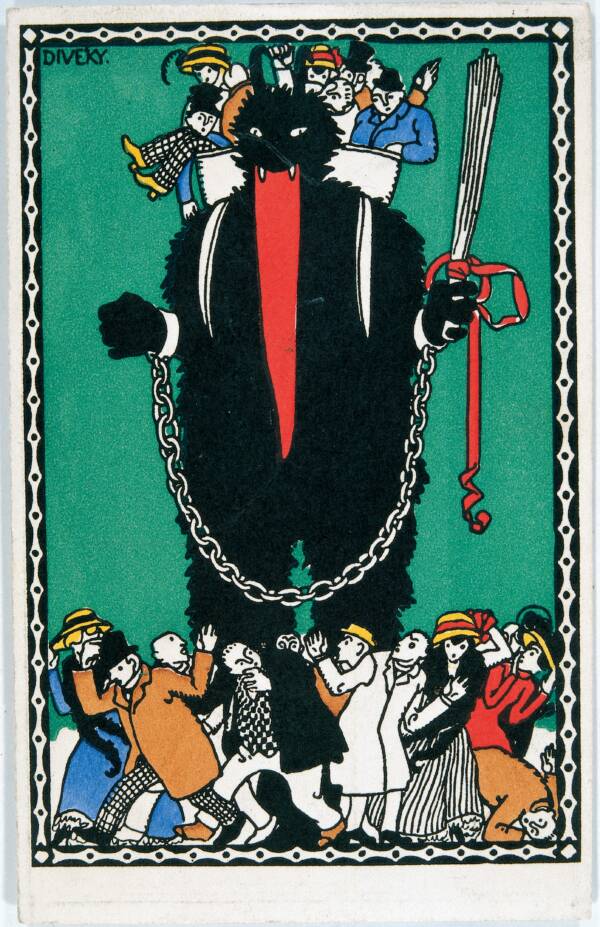Still celebrated by the descendants of German immigrants in America today, Belsnickel is a menacing character who bears some similarities to Santa Claus — but has a violent approach all his own.
In a 2012 episode of The Office, the character Dwight Shrute comes to work dressed as Belsnickel, a disheveled, switch-wielding screwball who gives out presents and punishments for Christmas. As his bemused colleagues soon realize, Belsnickel is no figment of Dwight’s overactive imagination, but a real figure from German folklore.
Indeed, Belsnickel has been celebrated by the descendants of German immigrants in the United States for years. The Pennsylvania Dutch regularly include this bewildering figure in their Christmas traditions, delighting in how he punishes naughty children and rewards well-behaved ones.
So where exactly did the legend of Belsnickel come from and what does he do? And how does this Christmas figure differ from others like Krampus?

The Legend Of The Belsnickel
Belsnickel’s origins can be traced to the Palatinate region of southwestern Germany, where he’s also sometimes called “Kriskinkle,” “Beltznickle,” “Pelsnichol,” and even the “Christmas woman” because of his sometimes feminine clothing. The name “Belsnickel” itself is a combination of the German word bels (fur) and nickel (St. Nicholas).

Pennsylvania Folklore SocietyPart of German Christmas mythology, Belsnickel plays a similar role to Santa Claus.
In German folklore, Belsnickel has a somewhat terrifying appearance. He’s described as having a face smeared with charcoal and wearing dirty, tattered clothes. Penn Live explains that Belsnickel adorns himself with bits of foliage, fur cloaks and hats, and even deer antlers. In his hand, he carries a switch.
But while the legend of Belsnickel seems a far cry from the legend of Santa Claus — who is generally presented as jolly and smartly dressed in red and white — this German mythological figure does play a somewhat similar role.
What Does The Belsnickel Do?
Like Santa Claus, Belsnickel’s main role is to determine if children have been good or bad. But he goes about his duties in an entirely different way.
As Penn Live reports, Belsnickel will usually appear at children’s homes one or two weeks before Christmas. Instead of sneaking down the chimney like Santa, he’ll rap on the windows with his switch. Then Belsnickel will charge into the house and start asking the children if they’ve been well-behaved.

NY State Parks and Historic SitesA man dressed as Belsnickel, wearing the customary fur cloak and hat.
Children must answer Belsnickel’s questions and are sometimes required to recite passages from the Bible. Belsnickel will then throw cakes, candies, and nuts on the floor — but beware! If the children dive for the sweets on the ground, they might get a swat with Belsnickel’s switch for being greedy.
In the end, children who have convinced Belsnickel of their goodness will be rewarded. Children unable to answer his questions or prove their good deeds will be punished with his switch.
The Belsnickel Tradition Today
In the German tradition, which was carried by immigrants to places like New York and Pennsylvania, adults would play the role of this odd Christmas figure by donning masks and furs.
“The annual visitor would make his appearance some hours after dark, thoroughly disguised, especially the face, which would sometimes be covered with a hideously ugly phiz,” explained Alfred Shoemaker and Don Yoder in the book Christmas in Pennsylvania: A Folk Cultural Study, according to Penn Live.

Luray Valley Museum/Museum of the Shenandoah ValleyA Belsnickel devil mask from the early 20th century.
“He or she would be equipped with an ample sack about the shoulders filled with cakes, nuts, and fruits, and a long hazel switch,” the passage continues. “One would scatter the goodies upon the floor, and then the scramble would begin by the delighted children, and the other hand would ply the switch upon the backs of the excited youngsters – who would not show a wince, but had it been parental discipline there would have been screams to reach a long distance.”
Though the Belsnickel tradition largely faded away after World War II — German traditions plummeted in popularity worldwide following the conflict — it has enjoyed a resurgence in popularity in recent years. Indeed, Belsnickel is still heartily celebrated among the Pennsylvania Dutch.
But though Belsnickel may seem like a strange Christmas character, he’s hardly the strangest or most sinister in European folklore.
Other Christmas Figures Of European Folklore
Alongside Santa Claus variations in Europe — like Sinterklaas and St. Nicholas — there are also several more menacing Christmas characters in the mold of Belsnickel.
In France, Père Noël (Father Christmas) is accompanied by Père Fouettard (or Father Whipper). He’s somewhat similar to Belsnickel in that he’s covered in soot and dressed in rags. Like Belsnickel, Père Fouettard is also known to whip naughty children, as well as give them lumps of coal.
And from Belsnickel’s native Germany, there’s also the terrifying Christmas legend of Krampus. Like Belsnickel and Père Fouettard, Krampus is known to punish naughty children. Unlike them, Krampus’s roots are deeply pagan, and some believe that his origins can be traced to Nordic deities.

Imagno/Getty ImageA Krampus card from circa 1910. Here, Krampus is depicted carting off naughty children in his sack.
Also unlike other Christmas characters, Krampus went to great lengths to punish naughty children. German legend states that the half-goat beast would forcibly stuff naughty children into his sack so that he could eat them or drag them to his lair and make them repent for their sins.
As such, Belsnickel is in good company. Similar to Père Fouettard, Krampus, and others, he plays an important role in Christmas traditions by holding children to their promise to be good.
“Personally, I think we’re missing a little bit of that these days,” Rick Brouse, a Belsnick impersonator, told the York Daily Record. “[T]here’s no real consequences for, you know, for some of the bad things you did or do. Back in the older days, there was a consequence for not being good.”
Dwight Schrute probably would agree.
In any case, celebrants of Christmas everywhere should keep an ear out when the holiday rolls around next. That scraping you hear on the window might not be branches outside, but Belsnickel and his switch.
After reading about the legend of the Belsnickel, go inside some of the most terrifying Christmas traditions from around the world. Or, look through these weird vintage Christmas ads from yuletides past.






